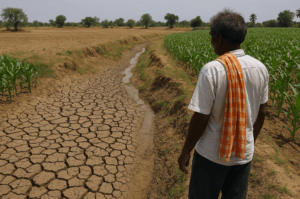India’s Water Crisis: 3 Powerful Solutions That Could Save Farming Communities from Collapse
With 18% of humanity relying on 4% of global freshwater, India faces a dire water emergency. Per capita availability has dropped 20% since 2000, and demand could double supply by 2030. Haryana’s Mera Pani Meri Virasat scheme, which pays farmers ₹7,000/acre to replace water-guzzling paddy with drought-resistant crops, shows promise but falters in low-lying areas.
Individual incentives fail here: trapped between income loss and aquifer depletion, farmers lack motivation to conserve shared resources. Lessons from Punjab and Andhra Pradesh reveal group incentives—rewarding villages for collective water savings—reduce free-riding and align individual-community goals. Challenges like trust gaps, inequitable land rights, and monitoring costs require tech-driven transparency (satellite audits, blockchain) and support for smallholders.
India’s survival hinges on policies that prioritize community-led conservation over isolated efforts, ensuring water security for future generations. Views expressed are the authors’ own.

India’s Water Crisis: 3 Powerful Solutions That Could Save Farming Communities from Collapse
India’s water scarcity is no longer a distant threat—it’s a daily reality. With 18% of the global population relying on just 4% of the world’s freshwater, the math is stark. Annual precipitation of 4,000 billion cubic meters (bcm) seems ample, but only 1,121 bcm is usable. Compounding this, per capita water availability has plunged by 20% since 2000 and could drop another 20% by 2050. By 2030, demand may outstrip supply by twofold, warns NITI Aayog. For farmers in states like Haryana, where groundwater levels have plummeted by 50% in a decade, the crisis is existential.
Haryana’s Experiment: Financial Incentives Meet Farming Realities
In response, Haryana launched Mera Pani Meri Virasat (“My Water, My Heritage”) in 2020, offering ₹7,000 per acre to farmers who replace water-intensive paddy with drought-resistant crops like maize, pulses, or oilseeds. While over 66,000 acres shifted in 2023, the scheme’s individual-focused incentives reveal gaps. Farmers in low-lying regions, where water naturally accumulates, face dilemmas: switching crops reduces income, yet sticking with paddy depletes shared aquifers. This paradox highlights a critical flaw—individual rewards may not address collective resource dependence.
The Case for Group Incentives: Lessons from Community-Led Conservation
Research suggests that water conservation thrives on community action. In Punjab’s Pani Bachao, Paisa Kamao initiative, groups of farmers received subsidies for reducing groundwater use collectively, leading to a 15–20% drop in consumption. Similarly, Andhra Pradesh’s community-managed groundwater systems improved sustainability by aligning individual and communal benefits.
For Haryana’s low-lying areas, group incentives could:
- Prevent Free-Riding: Reward villages, not individuals, for meeting water-saving targets, ensuring shared responsibility.
- Leverage Natural Hydrology: Redirect accumulated water to recharge aquifers or irrigate communal lands.
- Boost Bargaining Power: Farmer collectives could negotiate better prices for alternative crops, mitigating income risks.
Challenges Ahead: Trust, Equity, and Data
Group models require robust governance. Trust deficits, unequal landholdings, and monitoring costs pose hurdles. Satellite-based water audits and blockchain-led transparency, as piloted in Karnataka, could help. Equally vital is addressing disparities—marginal farmers need upfront support to transition crops without bearing undue risk.
A Thirsty Future Demands Collective Solutions
India’s water crisis cannot be solved by isolated efforts. While Haryana’s scheme is a start, reimagining incentives to harness community strengths could turn the tide. As climate uncertainty grows, policies must blend innovation with inclusivity—because every drop saved today is a lifeline for tomorrow.
You must be logged in to post a comment.